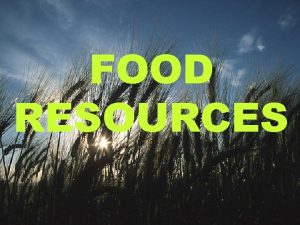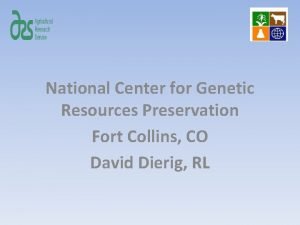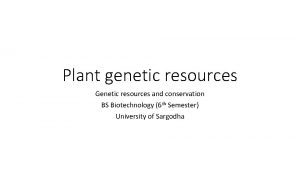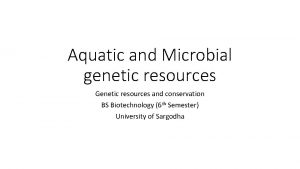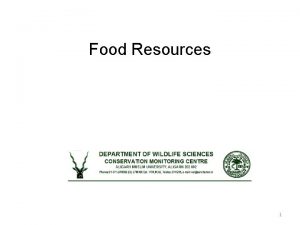Plant Genetic Resources Our challenges our food our












- Slides: 12

Plant Genetic Resources: Our challenges, our food, our future 2 nd June 2016 CUPGR: a context N. Maxted

Scope and ambition o Scope: LR, CWR, MP & WHS Goal is efficient and effective PGR conservation AND USE

Challenge of the world’s food security Earth Policy Institute (2013)

What is a crop wild relative (CWR)? A crop wild relative is a wild plant taxon that has an indirect use derived from its relatively close genetic relationship to a crop; Crambe maritima Beta vulgaris var. maritima this relationship is defined in terms of the CWR belonging to gene pools 1 or 2, or taxon groups 1 to 4 of the crop

Climate change as a threat to Food Security and CWR Threat - The International Panel on Climate Change (IPCC) estimates that by 2100, wheat yields in Europe will decrease by up to 40% unless climate change mitigation is undertaken + CWR are important for mitigating the impact of climate change because their genetic diversity provides greater resistance to drought, flooding, salt or heat Evidence includes: • Jarvis et al. (2008): generated climatic envelopes for Arachis, Solanum and Vigna and compared current distribution with 2055 range: — For three crop genera, 16– 22% of CWR taxa will become extinct — Most species will lose 50% of their range and range highly fragmented — Effects vary depending on crop gene pools; the worst case is peanut, (Arachis spp. ) with 24– 31 taxa (out of 50) becoming extinct and range decreasing by 85– 94% for extant spp. • Ureta et al. (2012) 16 -39% range reduction for maize CWR by 2050 Tunisia not Europe: YET!!!!

Setting the scene No-dispersal scenario No. of CWR taxa Relatedness category No. of CWR losing > 50% range Optimistic dispersal scenario Average % area No. of taxa losing Average % area loss (SD) > 50% loss (SD) Primary gene pool 94 3 -18. 35 (15. 25) 2 16. 75 (144. 47) Secondary gene pool 241 23 -23. 53 (23. 94) 22 -3. 99 (50. 52) Tertiary gene pool 91 1 -15. 53 (15. 95) 1 7. 75 (33. 44) CC Modelling for 2050 Castenada et al. In Prep.

Climate change has changed the game Climate change reduce agricultural production by 2% per decade (IPCC, 2014), but demand increases 14% FAO (2011) CWR are important mitigating CWR may holdfor one key to the impact of climate change because their human survival • Wide genetic provides diversity of adaptive genetic diversity greatertraits • Tried, proven but still largely unapplied resistance to drought, flooding, salt or • Technological advances in application heat 2015 @ 12%/Oman 2020 @ 17. 4%/Oman 2050 @ 2. 3% of Food insecurity & human malnourishment is a real problem in our lifetimes

Why crop wild relatives? CWR are threatened and poorly conserved § Red List assessments of 572 native European CWR in 25 Annex I priority crop gene pools - 16% of the species assessed are threatened or Near Threatened and 4% are Critically Endangered § Yet analysis of PGR ex situ collections found: - CWR taxa represent only 10% of total germplasm accessions - Castañeda et al. (2016) reviewed ex situ holdings found ⅓ unconserved ⅓ poorly conserved (<10 accessions) § Many CWR are found in existing protected areas, but they are not being actively monitored and managed § Only a handful of CWR active genetic reserves have been established: Triticum CWR in Israel; Zea perennis in Mexico; Solanum CWR in Peru; wild Coffee CWR in Ethiopia; and Beta patula in Madeira

National CWR Strategy Progress in Europe: Albania, Azerbaijan, Belarus, Bulgaria, Cyprus, Czech Rep. , Finland, Greece, Ireland, Italy, Portugal, Norway, Spain, Sweden and United Kingdom Progress in outside Europe: Armenia, Bolivia, Madagascar, Sri Lanka and Uzbekistan, Middle East, Mexico, Peru, India

Working definition of landraces Characteristics: A landrace is a dynamic population of a cultivated plant species that has 1. historical origin, 2. distinct identity and 3. lacks formal crop improvement, 4. genetically diverse, 5. locally adapted and associated with 6. traditional farming systems 7. cultural associations Camacho Villa et al. (2005)

Indigenous PGR: Landraces Recent inventories indicate that extensive LR diversity in UK cereals, forage crops, and fruit and vegetables (Scholten et al. , 2003; Kell et al. , 2009). Highly threatened by – No idea how many LR exist – Landrace maintainers are old (> 65) – Farmers grow for economic return – Seed companies promoting modern cultivar replacement of LR – No agency has direct responsibility – No comprehensive inventory of LR

Threat Facing LRs 1903 1983 Rural Advancement Foundation International (1983) via National Geographic (2011)
 Specation
Specation Genetic programming vs genetic algorithm
Genetic programming vs genetic algorithm Genetic programming vs genetic algorithm
Genetic programming vs genetic algorithm Genetic drift
Genetic drift Genetic drift vs genetic flow
Genetic drift vs genetic flow Changes caused by agriculture and overgrazing
Changes caused by agriculture and overgrazing National center for genetic resources preservation
National center for genetic resources preservation Unit 2 food food food
Unit 2 food food food Food chain food chain food chain
Food chain food chain food chain What macromolecule is used for contracting muscles? *
What macromolecule is used for contracting muscles? * Difference between transforming and transformed resources
Difference between transforming and transformed resources Fixed and variable resources examples
Fixed and variable resources examples Renewable resources vs nonrenewable resources
Renewable resources vs nonrenewable resources





